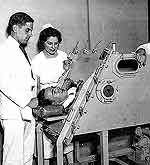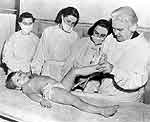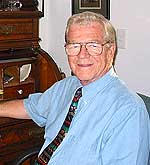By Dan Olson
Minnesota Public Radio
August 22, 2002
| |
|
|
|
||
Polio was frightening. It passed over most people, but struck others with crippling effects. Word of Elizabeth Kenny's treatment spread as polio's toll rose. In the 1940s, radio and newspapers carried accounts of the hundreds of victims who contracted the disease.
Beaches were closed. People stayed away from public gatherings for fear of catching the virus. The Minnesota State Fair was cancelled in 1946 to reduce polio's spread.
Polio was also called infantile paralysis because so many victims were children. South Minneapolis residents Edwin and Evelyn Hande's children were 2 and 6 when they contracted polio and were treated by Kenny. Both made a full recovery.
"Can't you just envision kids with all this paralysis, wheelchairs or whatever. And I credit Sister Kenny. I'd say that she was the one that did the trick," Edwin Hande said.
When Kenny sought endorsement of her physical therapy ideas for polio victims, she was literally laughed out of the offices of the American medical establishment.
| |
|
|
|
||
Vindication came when three prominent Minneapolis physicians took a chance on her. Some of their colleagues shunned them as a result of allowing Kenny to try her treatment.
Dr. Jennine Speier, director of the Minneapolis-based Kenny Rehabilitation Services at Abbott Northwestern Hospital, says her mentor, Dr. Miland Knapp, was one who wanted to give Kenny's approach a chance.
"Instead of like many physicians saying, 'This is hogwash, I don't understand her terminology, she doesn't know what she's talking about,' he said, 'I don't understand this, I have to learn more about it,'" Speier said.
Elizabeth Kenny's life as a crusading nurse - rising from obscurity to celebrity status - read like a Hollywood movie script. Indeed, in 1946, RKO Radio Pictures made a movie about her. One of Hollywood's top stars, Rosalind Russell, immortalized Elizabeth Kenny's story in the movie, Sister Kenny.
A 1952 Gallup poll showed Kenny was the most admired woman in America, edging out former first lady Eleanor Roosevelt. Kenny was modest about her success.
"This cannot be done with one's self alone. It is also written, 'I can, of my own self, do nothing.' This is true in my own experience," she said.
|
"They had me on a frame-like device that made it possible for my legs to be spread apart, and then my knees were bent in these things called Toronto splints, leather-covered hunks of aluminum that were bent at the knee."
- Dr. Richard Owen, describing his early treatment for polio |
Like many other viruses, polio lives all around us. Even before vaccines, most people were resistant and easily fought off its effects. But among people whose defenses were weak, polio spread quickly.
Polio paralyzed Richard Owen in 1940. He was 12 and growing up in Indianapolis, Ind., the son of a physician. Polio's symptoms misled many who tried to diagnose it. Owen thought he'd caught a cold or the flu.
"There's usually an illness with a fever, as the person gets an upper respiratory infection or a gastrointestinal infection. Then there's a quiescent period for a day, while the virus is working its way through the bloodstream and the central nervous system," Owen said. "In my case, I was sufficiently well that I went back to school for a day, and then the next day I was paralyzed."
Eventually, Owen was treated by Sister Kenny, and through a quirk of fate the disease became the focus of his professional life. Owen is a physician and the former medical director of the Sister Kenny Institute in Minneapolis. He's retired and lives in Eden Prairie.
Polio had been around for centuries, but Owen says it wasn't identified until the late 19th century.
| |
|
|
|
||
"In the 1880s they had some epidemics in Europe, and in 1916 they had a big one and the first group was Italian. So there was an anti-Italian uproar," Owen said.
The 1916 outbreak sparked the notion that the disease affected only poor people. That myth evaporated when polio spread among the rich and powerful.
Polio struck people all over the country, but for reasons not entirely clear it hit the Midwest hardest. Even then, it spared many, crippling only one out of 100 who caught the virus. Religious zealots explained the disease's mysterious and random nature as God's punishment.
Before Kenny's ideas were accepted, the standard medical treatment for polio victims looked like medieval torture. Patients were isolated and immobilized, strapped into metal braces.
"They had me on a frame-like device that made it possible for my legs to be spread apart, and then my knees were bent in these things called Toronto splints, leather-covered hunks of aluminum that were bent at the knee," Richard Owens said.
The 12-year-old Owen lay immobilized in splints and braces for nine months. It would be three years before he got the Kenny treatment, and was able to walk without braces.
More from MPR


